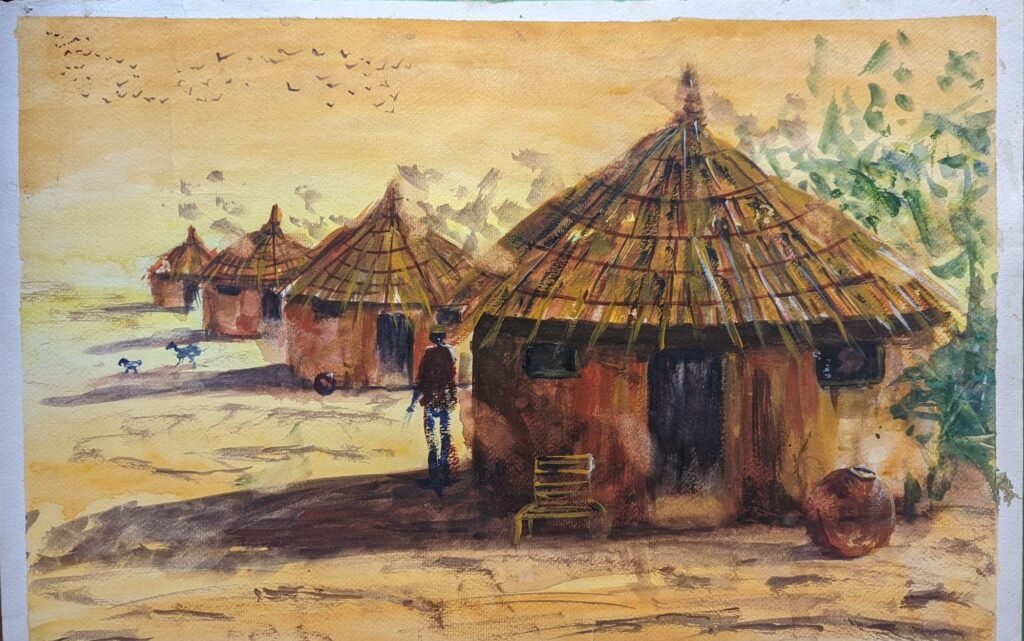
Introduction
Imagine stepping into a sunlit African village where the air is filled with the earthy scent of clay and the gentle rustle of thatched roofs in the breeze. This is the world that Home Sweet Home, a breathtaking watercolor painting, invites you to explore. With its warm, golden hues and intricate details, this artwork captures the essence of rural life in Africa, offering a glimpse into the traditions and simplicity that define such communities. In this blog post, we’ll delve into the visual beauty of this piece, uncover the cultural significance of the thatched houses it depicts, and reflect on why this painting resonates so deeply with viewers across the globe.
A Visual Journey Through Watercolor
At first glance, Home Sweet Home enchants with its serene depiction of a rural African village. The painting centers on a cluster of traditional thatched houses, their conical roofs meticulously crafted from straw, glowing under the soft light of either a rising or setting sun. The artist’s choice of watercolor as a medium brings a delicate, almost ethereal quality to the scene. The foreground features a prominent mud house, its walls painted in shades of terracotta and amber, with a rustic clay pot and a simple wooden chair placed nearby, evoking a sense of homely warmth. A lone figure, dressed in traditional attire, stands near the house, casting a gentle shadow that adds depth and dimension to the composition. In the background, additional huts fade into the hazy distance, their forms softened by the warm light, while a flock of birds soars across the sky, infusing the scene with a sense of freedom and tranquility. A small animal, possibly a dog, trots in the distance, adding a touch of everyday life to the arid landscape.
The artist’s mastery of watercolor is evident in the subtle gradients of color that define the scene. The earthy palette—dominated by ochre, amber, and terracotta—captures the dry, sunbaked environment typical of many African regions. The thatched roofs are rendered with fine, linear strokes that mimic the texture of straw, while the mud walls exhibit a soft, almost tactile quality through the layering of translucent washes. The interplay of light and shadow is particularly striking, with the sun casting long, gentle shadows that enhance the three-dimensionality of the huts. A hint of green foliage on the right side of the painting suggests sparse vegetation, providing a subtle contrast to the otherwise warm tones and grounding the scene in a natural setting.
The Cultural Roots of Thatched Houses
The thatched houses depicted in Home Sweet Home are more than just architectural elements—they are a testament to the rich cultural heritage of Africa, particularly in Nigeria. In Nigeria, such houses are a common sight in rural areas, especially among ethnic groups like the Hausa, Yoruba, and Igbo. In the northern regions, the Hausa people are renowned for their mud houses, often decorated with intricate patterns, where thick walls provide insulation against the intense heat of the Sahel. The conical thatched roofs, made from locally sourced materials like grass or palm fronds, are designed for practicality—offering excellent ventilation while being easily renewable, making them a sustainable choice for the environment. This architectural style has been passed down through generations, dating back centuries, and reflects a deep connection to the land and its resources.
Beyond Nigeria, thatched houses are a hallmark of traditional architecture across Africa. In East Africa, the Maasai of Kenya and Tanzania build similar structures, often circular, using a framework of wooden poles plastered with a mixture of mud and dung, topped with thatched roofs. In West Africa, communities in countries like Ghana and Mali also utilize this style, adapting it to their specific climates and resources. These homes are not just practical but also deeply symbolic, often representing community, resilience, and a harmonious relationship with nature. In many African cultures, the act of building a home is a communal effort, with families and neighbors coming together to construct these structures, reinforcing social bonds. Even today, while modern materials like iron sheets or cement are sometimes incorporated, the thatched roof remains an iconic feature, preserving the aesthetic and functionality of this ancestral design.
Why “Home Sweet Home” Resonates
What makes Home Sweet Home so compelling is its ability to evoke a profound sense of nostalgia and belonging. The simplicity of the village scene, paired with the artist’s skillful use of watercolor, creates a timeless quality that transcends cultural and geographical boundaries. For those familiar with rural African life, the painting may stir memories of childhood or ancestral roots, while for others, it offers a window into a way of life that feels both distant and deeply human. The warm tones and gentle composition create a feeling of peace, reminding us of the beauty found in the everyday—whether it’s the quiet moment…
1 Comment
Abdulrahman Aderibigbe · May 16, 2025 at 9:58 pm
VERRY IMPRESSING